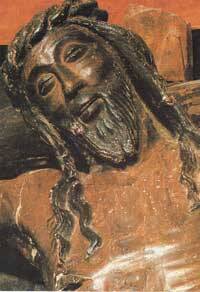In this holiest of all weeks, Christians are confronted by the crucified redeemer on Good Friday, before coming to new life with Jesus Christ the risen Lord on Easter Sunday. How do we imagine the death of Jesus?
One relatively unknown way of imagining Jesus on the cross comes from a crucifix, probably from the 13th century, found in the chapel of the castle of St. Francis Xavier, in northeast Spain. His suffering is clear: Jesus is stripped, arms outstretched, head crowned with thorns; he is nailed to the wood. His face is unusual, however, not wracked with pain, but peaceful and serene. The sculpture is called “the smiling Christ.” Shocking! Is this blasphemy or deep insight? Why such serenity in the midst of suffering, a smile at the moment of death?
The Seven Last Words—From Suffering to Glory. The most shocking words of Jesus on the cross are those in the Gospels of Mark and Matthew: “My God, my God, why have you abandoned me?” The Father seems absent to the Son. Pain, suffering and spiritual desolation dominate. Then the mood shifts. Forgiveness and mercy emerge as Jesus prays for his executioners, “Father, forgive them, they know not what they do” (Lk 23:34). To the good thief Jesus proclaims, “I assure you: this day you will be with me in paradise” (Lk 23:43). Jesus lovingly entrusts his mother to the beloved disciple. Finally, after proclaiming “I am thirsty,” and sipping the wine, Jesus says, “Now it is finished” (Jn 19:30). He bows his head and delivers over his spirit (Jn 19:30). In John’s account the cross is the exaltation of Jesus. In Luke’s Gospel as well, the moment of death is a positive act of love: “Jesus uttered a loud cry and said, ‘Father, into your hands I commend my spirit’” (Lk 23:46). Surely all these texts give some basis for the figure of the “smiling Christ,” which depicts Jesus in death entrusting himself into his Father’s loving hands.
The centurion’s reaction to the death of Christ too points in this direction. According to Mark, “when the centurion who stood facing him saw how he breathed his last he said ‘Truly this man was the Son of God’”(Mk 15:38). One theologian called the moment of death of the smiling Christ “the non-existent boundary between the cross and the resurrection.” In fact, Jesus said to the good thief that “today”, not in three days, not on Easter Sunday, but “today you will be with me in Paradise!”
Our Sharing in the Paschal Mystery. Is not this image of the smiling Christ reflected in the deaths of some saints, too? In the midst of their passion and pain, even in the face of death, they keep faith and manifest a sense of joy. St. Thomas More joked with his executioner: “Be not afraid. You send me to God.” In the words of St. Ambrose, St. Agnes went to her place of execution “more cheerfully than others to their wedding.” The martyrs of Uganda and of Japan went joyfully to their death, reciting the Rosary and loudly singing psalms of praise and joy.
We may never be called upon to suffer and die as did Jesus Christ or the martyrs. Yet the liturgies of Holy Week remind us that the cross is the only way to life. For those who are faithful, Good Friday leads to Easter Sunday. The smiling Christ points to a loving Father, who at the moment of deepest suffering reaches down in love to accept the life and work of his Beloved Son. Love triumphs over death.
Christianity does not promise us freedom from suffering, but reveals a more significant truth: it is through suffering that we are saved. Nothing can separate us from the love of Christ—no trial, distress, persecution or cross: “nothing in life or death will be able to separate us from the love of God that comes to us in Christ Jesus, our Lord” (Rom 8:38-39).
The first in this series of Lenten reflections had a paradox as its title: “A Sorrowful Joy.” We end with a paradoxical image, that of the smiling Christ, peaceful and serene at the moment of death. May this face illumine our way to the full joy and peace of the Resurrection.








